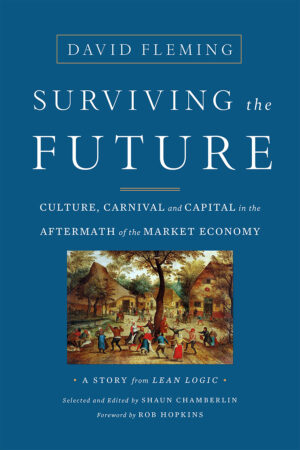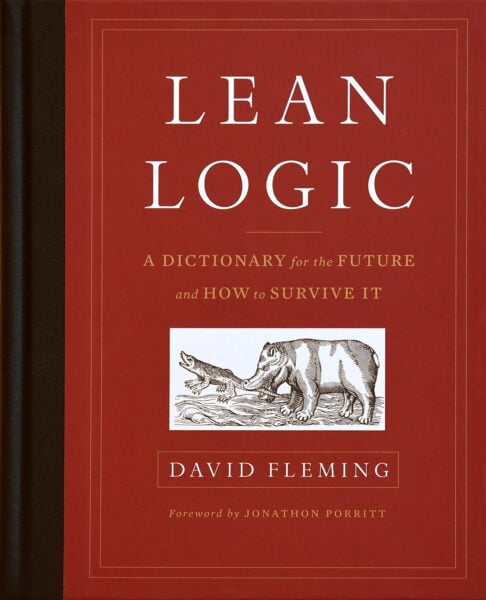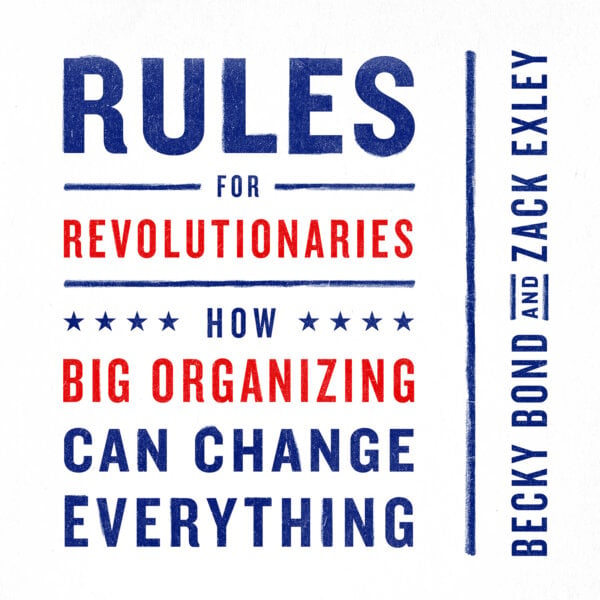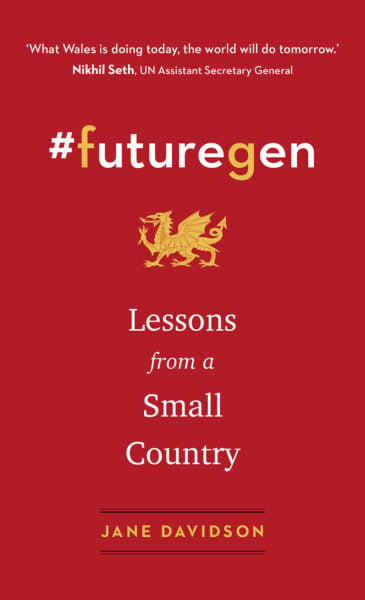The 5 Rules of Lean Thinking

Surviving the Future is a story drawn from the fertile ground of the late David Fleming’s extraordinary Lean Logic: A Dictionary for the Future and How to Survive It. That hardback consists of four hundred and four interlinked dictionary entries, inviting readers to choose their own path through its radical vision.
Fleming’s long-time collaborator Shaun Chamberlin has selected and edited one of these potential narratives to create Surviving the Future:Culture, Carnival and Capital in the Aftermath of the Market . The content, rare insights, and uniquely enjoyably writing style remain Fleming’s, but are presented here at a more accessible paperback-length and in conventional read-it-front-to-back format.
Fleming believed that the market economy will not survive its inherent flaws beyond the early decades of this century, and that its failure will bring great challenges, but he did not dwell on this: “We know what we need to do. We need to build the sequel, to draw on inspiration which has lain dormant, like the seed beneath the snow.”
The following is an excerpt from Surviving the Future. It has been adapted for the web.
Prefer audio?
Listen to the following excerpt from the audiobook of Surviving the Future.
Lean thinking is a frame of reference for enabling people to join together in a shared aim.
“Lean” in this sense was originally derived from industrial lean production in the post-war period, and the concept is widely applied in industry, as alluded to in the Introduction. Surviving the Future applies this frame of reference to the shared aim of rebuilding an economy and culture in place of the failing market.
 The essence of lean thinking is this. Two ways of making something happen can be compared. One of them—top-down management—is to tell people what to do: issue instructions, regulations, incentives, penalties, targets; exert managerial control; do the thinking for them; give orders, make sure they are carrying them out, check that they have done them right and, if they haven’t, tell them to do it again.
The essence of lean thinking is this. Two ways of making something happen can be compared. One of them—top-down management—is to tell people what to do: issue instructions, regulations, incentives, penalties, targets; exert managerial control; do the thinking for them; give orders, make sure they are carrying them out, check that they have done them right and, if they haven’t, tell them to do it again.
The other way is to set people up with the necessary resources, the skills and equipment, a common purpose, and the freedom to apply their judgment. This has advantages: it brings to life the imagination and tenacity of the people; it transforms the quality of decisions; it is flexible; it sets up conditions for alert observation and quick responses, responding to the local and real needs of the system, rather than to a distant caricature.
An example of what we are looking at here is the difference between, on the one hand, policy in which the government tells us what to do and is then obeyed with sceptical resignation; and, on the other hand, an agreed direction, enabled by a leadership which knows the difference between management and inspiration; and which makes it clear what the aims are and why they matter, switching on minds, ingenuity and motivation. Those aims are general—e.g., “to achieve this long-term reduction in collective energy use, as defined by the Energy Budget, in order to preserve a benign climate. And it is up to you how you do it, though you will get all the help you ask for”—as distinct from detailed instructions backed by rewards and penalties.
This is regime change—from disjointed regulation to freedom to think, from command-and-control to concentration on the matter in hand—and in lean thinking such dramatic change is termed kaikaku:
Kaikaku and kaizen
Kaikaku is the radical break; the collapse; the paradigm shift, often prompted by crisis. It is usually strongly-resisted, and it is a central idea in lean thinking, as it can open the way for the transformation of an elaborate and dysfunctional complex system to flexible elegance. Kaikaku is the enabling condition for the Lean Economy (see Chapter 2 and passim), but we should remember that it has its dangers, because it can also originate in a rationalist desire “to sweep a fist through the pieces which stand in the way, like the impatient chess-player”. At the large scale, the radical break’s value lies in its rarity.
Kaizen, by contrast, is incremental improvement, able to correct for errors guided by slight feedbacks or algorithms; like the steersman of a yacht. It may in due course be so prolific and elaborate that it becomes unsupportable and breaks in a shock of kaikaku.
Arthur Koestler’s herringbone visualisation helps illustrate the relationship between kaizen and kaikaku. Each line and arrow represents kaizen’s steady advance in one direction; each change in direction represents kaikaku’s radical change, followed by kaizen proceeding in the new direction. Note that the radical change in direction undoes some of the careful construction that preceded it—the new line does not start from the tip of the old one.
Of course, kaikaku may not happen. For one thing, feedbacks and corrections do not necessarily have to deliver incremental advance (kaizen); they may deliver stability, as in the case of species that remained unchanged over long periods, despite dramatic changes of climate. The serial reforms of our own time, however, are the troubled responses of a culture that has lost its identity and wits, and is struggling with vicious pre-climacteric problems to which there are no solutions. They are a pathology. Kaikaku approaches.
It may come without an invitation, in the form of a climacteric; or it may be the last resort embraced when faced by a system paralysed by autocratic top-down administration, or by large-scale dependencies and lines of supply that can no longer be supported, or by the death-trap whereby incremental improvements can do no more than deepen the trouble that a system is already in.
The five rules of lean thinking
The shift to lean thinking will be kaikaku, and yet, in a sense, there is nothing new about lean thinking. It is as old as politics and community, but it was business that rediscovered it and made it explicit in our own time, so the business context of the principle is still present. This turns out to be quite helpful, because business, especially lean production’s home territory of vehicle manufacturing—though far removed from post-market communities—provides a real-life setting for the five rules of lean thinking. Surviving the Future suggests its own labels for three of them; the original ones are given in brackets.
Each of these five rules needs all the others really, to be fully understood. Yet you may also notice that, in a sense, each of the five rules—intention, lean means, flow, pull and feedback—contains the whole story. If you think hard enough about any one of them it tends to draw you into an understanding of all the others:
1. Intention (Specify value)
The Intention defines what you want to achieve; it is the core around which every activity is organised and given shape. In industrial lean thinking, the Intention is to achieve “value”, and value is . . .
[a] capability provided to a customer at the right time at an appropriate price, as defined in each case by the customer.So, it works like this. We have a complex intention, and there are two ways of thinking about it. One way is to adopt a single task within that wider aim. It might be:

Require all workers to account for and record their time in full.
Now, why is that relevant to the Intention? What value does it bring? You might be able to think of ways in which customers get better value if all workers account for their time in full than if they don’t do so. But if, as we shall suppose for this example, it turns out that, after examination of the matter from all angles, it is just a case of bureaucratic form-filling, a tedious encumbrance which takes workers’ minds off their jobs, then it should not be there. Lean thinking travels light. It concentrates on what contributes to value—to the Intention—and does without things that don’t.
It sounds obvious; in action, it isn’t. Organisations sustain many practices that are irrelevant to what they are there to do. Sometimes they do so because other practices require it, such as a structure based on top-down command-and-control which requires exhaustive recordkeeping—if the recordkeeping were removed, the whole structure could collapse. That could be exactly the kaikaku event that is needed, but to the people around at the time, it is anything but obvious.
Another possible subsidiary task:
Make sure the handbrakes work.
Here we have identified an aim which at least has some relevance to making cars, though given such prominence that other aims, which are also intrinsic to “value”, risk being forgotten-about: you could end up with cars in which nothing worked but the handbrake. That is a caricature, of course, but it is not a remote one in the context of schools with state-of-the-art security cameras and collapsing discipline, farms with awesome labour-saving equipment and a deteriorating soil structure, urban districts whose smoothly-functioning social security system underwrites their crime and futility, factories whose milling machines work to a speed and accuracy far ahead of the rest of the system’s ability to keep up, or societies paralysed under the weight of regulation and control.
It is, of course, the aim that is wrong. The aim (again, it sounds obvious but it often isn’t to the harassed people in nominal command-and-control) should not be simply to produce handbrakes that work, but to produce cars that the customers want. We must resist the temptation to reduce any objective to the point where it seems to let us off the need to think about working with the system as a whole, offering instead the satisfaction of concentrating on a simplified, one-item, to-do list. This will only destroy the shared focus on the overall aim and rule out the possibility of discovering a common purpose.
And that would in turn open the way to Advanced Reductionism, where those iconic single-focus aims multiply, infesting the system like an extended family of clothes-moths. The cost of administering that collection of reductionist targets is high; inconsistencies either paralyse the system or impose a culture of pretence; creative invention is disallowed. The system becomes rigidly connected up; paralysed into incompetence. There is disempowerment—the task imposed on that busy ecology is to labour, but not to ask for any reward save the joy of catching each other out. The only participants who are happy with the situation are the managers, who think that more control is needed. Despite being rushed off their feet, they still can’t keep control, so it appears at first breathless glance that they have a point.
In contrast with all this, the Intention identifies the system’s deep, central, aims. That does not mean that the idea of “value” should be so focused that it itself becomes a reductionist aim, for the “capability provided to a customer” may in fact be quite complex and require reflection. The customer does not, for instance, want the company to go out of business, so she will expect it to make a profit; nor does she want to buy products from a company that pollutes the groundwater. So value—the Intention of an industrial enterprise—can be expressed in terms of responding to the claims of its numerous stakeholders, such as customers, shareholders, staff, the local community and the environment. The “triple bottom line” recognises companies’ obligations in terms of quality and income, and of the environment and social justice too.
What is non-negotiable is that the enterprise, having decided what it wants to do, must avoid being burdened either by a host of other kinds of urgent commitments which are nothing to do with that Intention, or by iconic reductionist obsessions which crowd out encounter with the system as a whole.
So, value is defined in terms of what the enterprise is ultimately for, and leaves out all the other things it may want to do, unless they are also relevant to that defining purpose. Since an enterprise is a complex system, many unexpected things may well be relevant, such as blue skies research and a generous pension scheme, but the connection between them and the Intention needs to be explicit. There may be seductive reasons for being distracted from what you are trying to do, but unless there is a plain reason in support of something being part of the enterprise’s Intention, it should be left out.
2. Lean means (Identify the value stream)
The Intention is defined, so now is the moment to purge the irrelevant—the legacy of stuff that clogs up and weighs down the system. For instance, in the case of a manufacturing company, you don’t have to maintain and pay for large numbers of supervisors to regulate the front-line workers on the assumption that no one can be trusted to think for themselves; you don’t need a large inspection and testing establishment if quality and judgment are intrinsic to every stage in the process. You don’t need arbitrary targets if there is a structure of motivation and trust, and a widely shared agreement on the Intention. Controls and written reports may in some circumstances be needed, but they do not in themselves add value, so they should be used only if they are essential to value being added. You don’t need centralisation if localisation will do as well or (more likely) better.
So get rid of all the irrelevant activities, elaborations and hassle (collectively known as muda) which tend to accumulate in organisations. That is, eliminate everything that isn’t part of the “value stream”. It turns out that in institutions (such as health, education and policing services), the greater fraction of their work consists of tasks other than what they are there to do. The scale of muda in an organisation is indicated by the scale of the savings that can be achieved when it is removed. Its removal can . . .
. . . double labor productivity all the way through the system. . . .
If you can’t quickly take throughput times down by half in product development, 75 percent in order processing, and 90 percent in physical production you are doing something wrong.
The existence of waste of this magnitude suggests that, in the settled, resilient economy of the future, travelling light is a realistic option. With lean thinking in place, and muda purged, the effectiveness of local economies in the future could exceed expectations and form the basis of a long-lived culture.
With the shock of kaikaku comes the sacrifice of much that may have been thought of as important or indispensable, and its replacement by lean-intelligent design, which is in turn followed by kaizen: incremental improvement, working out how to do what is necessary, and how to avoid what is not.
But, at the same time as purging the irrelevant, it is necessary to recruit the relevant—the set of means that is needed. There may be a lot of them, and not all of them will reveal themselves at first. For example, good ventilation is essential to good patient care, as Florence Nightingale discovered, too late for most of her patients at Scutari; soil structure depends on rotations and on the use of natural fertility and compost; a shared commons requires well-established conditions to be met if its users are to sustain it with the necessary autonomy, understanding and competence. Sifting the lean means from the irrelevant and achieving the needed convergence of focus and complexity may be difficult; it is an idea which, as is the way of systems, resists summary. In the end, learning about it means living it: heartbeat and respiration respond faithfully to—are pulled along exactly and promptly by—what the body needs.
3. Flow

Flow keeps the system moving at an even pace. The aim is to achieve a regular flow of work on a scale small enough for participants to be aware of—and to respond to—local diversity and detail. It enables incremental learning and improvement, and it invites participation from the people involved.
The lean industrial system delivers parts and finished goods as they are needed; it avoids large batches, bottlenecks and storage. There is no waiting time between frantic bursts of work; the system is synchronised. It is also connected up, so that tasks are arranged close to each other and in sequence; the people who are doing them can sort out problems together; their conversation enables their cooperation. There is a convergence of the system’s aptitudes, timings, circumstances and purpose.
But there is more to it than that. Flow is a key—perhaps the key—principle of a life that makes sense to the person who is living it. It is the experience of engagement in practice in something difficult, where prompt feedback tells you how well you are doing it, how to respond to it, how to be part of the music.
How do we get there? Well, the psychologist Mihaly Csikszentmihalyi, who has explored the meaning of flow, asked people to think about the most positive experiences of their lives, and to tell him how they came about, and what they felt while they were happening. He concluded that there are seven conditions. Flow is most likely to come with a task we have a reasonable chance of completing. We must have time to concentrate. There are clear goals (for instance, you really do want to get up that rock face without falling off). And, of course, there is that critical condition for most things in Surviving the Future—the rapid feedback: the task answers back; we are drawn into conversation; we are not alone. The last three items on Csikszentmihalyi’s list are not so much enabling conditions as reinforcing consequences: we forget (if only briefly) about our daily troubles; there is a suspension of our consciousness of time; and there is a sense of mastery, of knowing what we are doing.11
Flow means total engagement with the Intention. It means leaving out the irrelevant, letting the task itself pull our responses along with honesty and accuracy, being alert to feedback and learning by repetition. Here we have gone beyond a self-conscious, cool acknowledgement of lean thinking. It is about what we do and who we are. And when flow is taking place, the conditions are right for pull.
4. Pull
Pull recognises that the people best placed to deal with a complex task are those who are doing it—who are engaged with the practical detail. Once the system is connected up, action in one part of it is the cue for fitting responses in adjacent parts. Action and information converge. Everyone involved can see—or recognises that they must work out for themselves—what needs to be done to achieve the Intention; actions are focused responses to the particular.
This is how the two leading exponents of lean thinking explain it (“downstream” refers to activities nearer the completion of the process; “upstream” refers to activities nearer the start of the process):
[Pull is] a system of cascading production and delivery instructions from downstream to upstream activities in which nothing is produced by the upstream supplier until the downstream customer signals a need.
Each activity responds to the needs of the next one along: it is pulled along in sequence. No one has to stand there giving instructions about what to do; participants respond to the demands of the processes downstream from them, whose needs they have to supply. In a pull-system, the people involved do not simply apply rules they have been given; they apply their local knowledge and creative intelligence; they invent solutions; they discover ways forward which the management does not have to work out for itself. They see what is needed, and engage their brains.
In this context, aims can be defined without any reliable knowledge of how they are to be achieved, or even whether they are achievable, for pull can enable the creative discovery of means which are at present unknown or out of sight and which, when they are invented or revealed, may surprise.
5. Feedback (Perfection)
Reflect on results; improve the system incrementally. Check outcomes against Intention. Decide in the light of all this: is what you are trying to do realistic? Where are the gaps? Where is the room for improvement?
This is another of the features of lean thinking which seems obvious but which, on close inspection, turns out not to be. You can look at a system from the outside—and perhaps from a little bit above—and come to the conclusion that it is all working just fine, just as scale models of horrendous proposed city developments, with their tiny figures and tree-lined walkways, tend to look nice litter-free places to live. So, how is this error of misty-eyed complacency to be avoided?
Well, the first rule is: don’t look down at it from the sky. It is the people who are inside it who know it, and it is usually the dissidents, complainers and troublemakers who are most perceptive about it. What they are quite likely to see is the ways in which the bits do not join up: they will see the trade-offs: this can only work properly at the cost of this. But complex systems, given time and feedback, can usually do better than that: instead of trade-offs, with one part having to bear the cost of another, they develop ‘trade-ons’, where the service being provided by one part of the system for another is felt as a benefit by both the recipient and by the supplier. In contrast with the exchange relationships of economics, participants in such complementary relationships benefit directly from the very act of providing the goods and services to other parts of the system. Intrinsic advantage rolls through the system.
Lean thinking is a radical approach. It begins with the break of kaikaku, which may be hard to bear, as it is a profound change from previous assumptions and methods and so is usually resisted until a shock intervenes. The changed thinking that follows, approaching the system in a profoundly new way, moves ahead with incremental improvement and evolution, guided by experience and local detail.
It is a philosophy with wide application, shaped by the context. But there are significant differences between lean thinking as it is now widely applied in industry and the use that Surviving the Future makes of it—apart from the obvious one that the industrial case is about extending the flying-time of the market economy and Surviving the Future is about bringing it in to land.
Recommended Reads
Recent Articles
For too long, bugs have had a negative connotation associated with them. But what if we took the time to observe the benefits of insects? It’s time to rebug our gardens, lawns, and parks! The following is an excerpt from Rebugging the Planet by Vicki Hird. It has been adapted for the web. Adding Bugs:…
Read MoreAsparagus is a delicious vegetable with a layered history. How did this aspiring spear make its way from growing in the wild to appearing on our plates? The following is an excerpt from the The Seed Detective by Adam Alexander. It has been adapted for the web. “Nature gives us the key to every secret…
Read MoreChances are, you’ve seen cattails growing on the edge of your local lake or stream at least once or twice. Instead of just passing these plants, try foraging for and cooking them to create delicious seasonal dishes! The following excerpt is from The New Wildcrafted Cuisine by Pascal Baudar. It has been adapted for the…
Read MoreGarlic mustard: while known as “invasive,” this plant can be consumed in its entirety and has great nutritional value. Plus, the garlic-flavor is a perfect addition to any recipe that calls for mustard! The following are excerpts from Beyond the War on Invasive Species by Tao Orion and The Wild Wisdom of Weeds by Katrina…
Read MorePeregrine falcons, while known as predators, are essential to our environment. These stunning birds have a rich history, an interesting present, and an uncertain future. The following is an excerpt from Feather Trails by Sophie A. H. Osborn. It has been adapted for the web. Who Are Peregrine Falcons? Though relatively uncommon wherever it occurs,…
Read More









